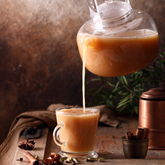Camellia sinensis is the botanical name for the tea plant, from which teas such as black, green, white, oolong, purple, and pu-erh teas are produced. A cousin of the garden camellia, camellia sinensis is an evergreen shrub that thrives in tropical and subtropical climates, and has been cultivated in order to produce tea for hundreds of years.
Camellia Sinensis varieties
The tea plant comes in two main varieties, each of which is slightly different in size, growing location, and flavor.
Camellia sinensis var. assamica
Camellia sinensis var. assamica is cultivated most often in India, particularly the Assam region, from which it gets its name. Most black teas are made from camellia sinensis var. assamica, as well as many pu-erh teas and some oolongs. This variety of camellia sinensis is larger and more robust, producing teas with a heartier flavor.
Camellia sinensis var. sinensis
Camellia sinensis var. sinensis is the other most common variety of the tea plant, from which green, white, and some oolong teas are often produced. This variety is native to China (sinensis is Latin for “from China”) and is typically smaller and more delicate, resulting in mellower teas.
The history and cultivation of camellia sinensis
Tea has been cultivated and consumed for hundreds of years. Archeological research even indicates that tea may have been drunk over two thousand years ago! Originating in southwest China and northeast India, camellia sinensis has a rich history and cultural significance in many countries all over the globe.
Today, tea is mainly grown in places like China, India, Japan, Nepal, and Vietnam, as well as several other south and east Asian countries. With proper cultivation methods, however, tea can be grown in a wide variety of locales, from Kenya to Hawaii and many places in between.
While all true teas are produced from camellia sinensis, the ways in which teas are processed result in many different varieties of tea, such as black, green, white, oolong, purple, and pu-erh. Some factors that go into producing different kinds of tea include oxidation level and processing techniques such as steaming, firing, rolling, and aging. Other circumstances that contribute to different varieties of tea include the use of specific cultivars and the terroirs in which tea is grown.
Camellia sinensis benefits
All tea made from camellia sinensis contains some amount of caffeine, making it a popular choice for a warming, uplifting morning drink. While black and pu-erh teas contain the highest amount of caffeine, other varieties such as white and purple teas contain relatively low amounts. Tea is also extremely high in antioxidants, and is rich with numerous other health benefits.
In addition to these positive effects, the act of brewing up a cup can be a soothing and meditative process. No matter what kind of tea you prefer, tea can be a great way to take a pause in a busy day and enjoy a delicious cup with a rich history!















